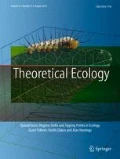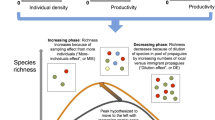Abstract
“Mass effects,” in which “sink populations” of locally inferior competitors are maintained by dispersal from “source populations” elsewhere in the landscape, are thought to play an important role in maintaining plant diversity. However, due to the complexity of most quasi-realistic forest models, there is little theoretical understanding of the strength of mass effects in forests. Here, we develop a metacommunity version of a mathematically and computationally tractable height-structured forest model, the Perfect Plasticity Approximation, to quantify the strength of mass effects (i.e., the degree of mixing of locally dominant and subordinate species) in heterogeneous landscapes comprising different patch types (e.g., soil types). For realistic levels of inter-patch dispersal, mass effects are weak at equilibrium (i.e., in the absence of disturbance), even in some cases where differences in growth, mortality, and fecundity rates between locally dominant and subordinate species are too small to be reliably detected from field data. However, patch-scale transient dynamics are slow following catastrophic disturbance (in which post-disturbance initial abundances are determined exclusively by immigration) so that at any given time, subordinate species are present in appreciable numbers in most patches. Less severe disturbance regimes, in which some seeds or individuals survive the disturbance, should result in faster transient dynamics (i.e., faster approach to the low-diversity equilibrium). Our results suggest that in order for mass effects to play an important role in tree coexistence, niche differences must be strong enough to prevent neutral drift, yet too weak to be reliably detected from field data.



Similar content being viewed by others
References
Adams TP, Purves DW, Pacala SW (2007) Understanding height-structured competition in forests: is there an R* for light? Proc R Soc London, Ser B 274:3039–3047
Amarasekare P, Nisbet RM (2001) Spatial heterogeneity, source–sink dynamics, and the local coexistence of competing species. Am Nat 158:572–584
Brokaw N, Busing RT (2000) Niche versus chance and tree diversity in forest gaps. Trends Ecol Evol 15:183–188
Burns RM, Honkala BH (1990) Silvics of North America: 1. Conifers; 2. Hardwoods. Agriculture Handbook 654. U.S. Department of Agriculture, Forest Service, Washington, DC
Canham CD (1985) Suppression and release during canopy recruitment in Acer saccharum. Bull Torrey Bot Club 112:134–145
Canham CD (1990) Suppression and release during canopy recruitment in Fagus grandifolia. Bull Torrey Bot Club 117:1–7
Canham CD, Finzi AC, Pacala SW, Burbank DH (1994) Causes and consequences of resource heterogeneity in forests: interspecific variation in light transmission by canopy trees. Can J For Res 24:337–349
Canham CD, Loucks OL (1984) Catastrophic windthrow in the presettlement forests of Wisconsin. Ecology 65:803–809
Chave J (2004) Neutral theory and community ecology. Ecol Lett 7:241–253
Clark JS, Bell D, Chu CJ et al (2010) High-dimensional coexistence based on individual variation: a synthesis of evidence. Ecol Monogr 80:569–608
Clark JS, Dietze M, Chakraborty S, Agarwal PK, Ibanez I, LaDeau S, Wolosin M (2007) Resolving the biodiversity paradox. Ecol Lett 10:647–659
Clark JS, Mohan J, Dietze M, Ibanez I (2003) Coexistence: how to identify trophic trade-offs. Ecology 84:17–31
Clark JS, Silman M, Kern R, Macklin E, HilleRisLambers J (1999) Seed dispersal near and far: patterns across temperate and tropical forests. Ecology 80:1475–1494
Condit R, Ashton P, Bunyavejchewin S et al (2006) The importance of demographic niches to tree diversity. Science 313:98–101
Connell JH (1978) Diversity in tropical rain forests and coral reefs. Science 199:1302–1310
Connell JH, Slatyer RO (1977) Mechanisms of succession in natural communities and their role in community stability and organization. Am Nat 111:1119–1144
Curtis JT (1959) The vegetation of Wisconsin: an ordination of plant communities. University of Wisconsin Press, Madison
Dietze MC, Wolosin MS, Clark JS (2008) Capturing diversity and interspecific variability in allometries: a hierarchical approach. For Ecol Manage 256:1939–1948
Foster DR, Knight DH, Franklin JF (1998) Landscape patterns and legacies resulting from large, infrequent forest disturbances. Ecosystems 1:497–510
Gravel D, Canham CD, Beaudet M, Messier C (2010) Shade tolerance, canopy gaps and mechanisms of coexistence of forest trees. Oikos 119:475–484
Hastings A (1980) Disturbance, coexistence, history, and competition for space. Theor Popul Biol 18:363–373
Holt RD (1993) Ecology at the mesoscale: the influence of regional processes on local communities. In: Ricklefs RE, Schluter D (eds) Species diversity in ecological communities: historical and geographical perspectives. University of Chicago Press, Chicago, pp 77–88
Horn HS (1971) The adaptive geometry of trees. Princeton University Press, Princeton
Hubbell S, Foster RB (1986) Biology, chance and history and the structure of tropical rain forest tree communities. In: Diamond JM, Case TJ (eds) Community ecology. Harper and Row, New York, pp 314–329
Hubbell SP (2001) The unified neutral theory of biodiversity and biogeography. Princeton University Press, Princeton
Huston M (1979) A general hypothesis of species diversity. Am Nat 113:81–101
Kohyama T (1993) Size-structured tree populations in gap-dynamic forest—the forest architecture hypothesis for the stable coexistence of species. J Ecol 81:131–143
Leibold MA, Holyoak M, Mouquet N et al (2004) The metacommunity concept: a framework for multi-scale community ecology. Ecol Lett 7:601–613
Levin SA (1974) Dispersion and population interactions. Am Nat 108:207–228
Levin SA (1976) Population dynamic models in heterogeneous environments. Annu Rev Ecol Syst 7:287–310
Levin SA, Paine RT (1974) Disturbance, patch formation, and community structure. Proc Natl Acad Sci USA 71:2744–2747
Lichstein JW, Dushoff J, Levin SA, Pacala SW (2007) Intraspecific variation and species coexistence. Am Nat 170:807–818
Lichstein JW, Dushoff J, Ogle K, Chen AP, Purves DW, Caspersen JP, Pacala SW (2010) Unlocking the forest inventory data: relating individual tree performance to unmeasured environmental factors. Ecol Appl 20:684–699
May RM (1976) Simple mathematical models with very complicated dynamics. Nature 261:459–467
Molino JF, Sabatier D (2001) Tree diversity in tropical rain forests: a validation of the intermediate disturbance hypothesis. Science 294:1702–1704
Mouquet N, Loreau M (2002) Coexistence in metacommunities: the regional similarity hypothesis. Am Nat 159:420–426
Mouquet N, Loreau M (2003) Community patterns in source–sink metacommunities. Am Nat 162:544–557
Pacala SW, Canham CD, Saponara J, Silander JA, Kobe RK, Ribbens E (1996) Forest models defined by field measurements: estimation, error analysis and dynamics. Ecol Monogr 66:1–43
Pacala SW, Canham CD, Silander JA (1993) Forest models defined by field measurements: I. the design of a northeastern forest simulator. Can J For Res 23:1980–1988
Purves DW, Lichstein JW, Pacala SW (2007) Crown plasticity and competition for canopy space: a new spatially implicit model parameterized for 250 North American tree species. PLoS ONE 2:e870
Purves DW, Lichstein JW, Strigul N, Pacala SW (2008) Predicting and understanding forest dynamics using a simple tractable model. Proc Natl Acad Sci USA 105:17018–17022
Ribbens E, Silander JA, Pacala SW (1994) Seedling recruitment in forests: calibrating models to predict patterns of tree seedling dispersion. Ecology 75:1794–1806
Shmida A, Ellner S (1984) Coexistence of plant species with similar niches. Vegetatio 58:29–55
Shmida A, Wilson MV (1985) Biological determinants of species diversity. J Biogeogr 12:1–20
Strigul N, Pristinski D, Purves D, Dushoff J, Pacala S (2008) Scaling from trees to forests: tractable macroscopic equations for forest dynamics. Ecol Monogr 78:523–545
Tilman D, Pacala S (1993) The maintenance of species richness in plant communities. In: Ricklefs RE, Schluter D (eds) Species diversity in ecological communities: historical and geographical perspectives. University of Chicago Press, Chicago, pp 13–25
Van Cleve K, Dryness C, Viereck L, Fox J, Chapin FS, Oechel W (1983) Taiga ecosystems in interior Alaska. Bioscience 33:39–44
von Foerster H (1959) Some remarks on changing populations. In: Stohlman F (ed) The kinetics of cellular proliferation. Grune and Stratton, New York, pp 382–407
Whittaker RH (1956) Vegetation of the Great Smoky Mountains. Ecol Monogr 26:1–69
Whittaker RH, Levin S (1977) The role of mosaic phenomena in natural communities. Theor Popul Biol 12:117–139
Wright EF, Canham CD, Coates KD (2000) Effects of suppression and release on sapling growth for 11 tree species of northern, interior British Columbia. Can J For Res 30:1571–1580
Acknowledgments
We thank Simon Levin for his dedication to teaching and for inspiring us to strive for clarity in our thinking and writing. We thank two anonymous reviewers and Caroline Farrior for helpful comments and Ray Dybzinski for encouragement. JWL was supported by the Princeton Carbon Mitigation Initiative (with funding from BP and Ford) and by the USDA Forest Service Northern Research Station.
Author information
Authors and Affiliations
Corresponding author
Electronic supplementary materials
Below is the link to the electronic supplementary material.
Rights and permissions
About this article
Cite this article
Lichstein, J.W., Pacala, S.W. Local diversity in heterogeneous landscapes: quantitative assessment with a height-structured forest metacommunity model. Theor Ecol 4, 269–281 (2011). https://doi.org/10.1007/s12080-011-0121-5
Received:
Accepted:
Published:
Issue Date:
DOI: https://doi.org/10.1007/s12080-011-0121-5




